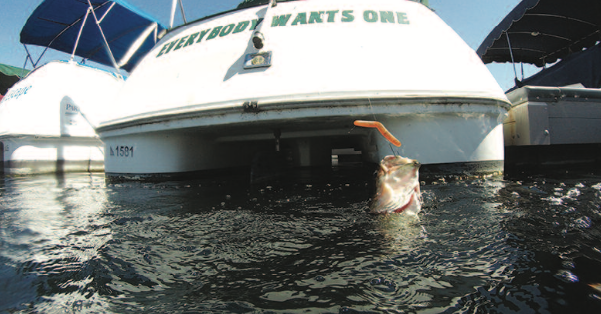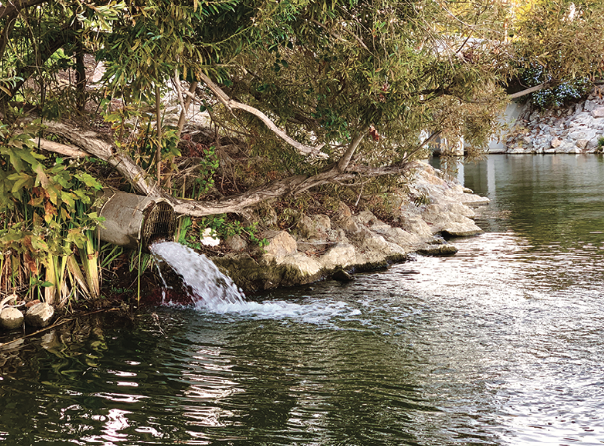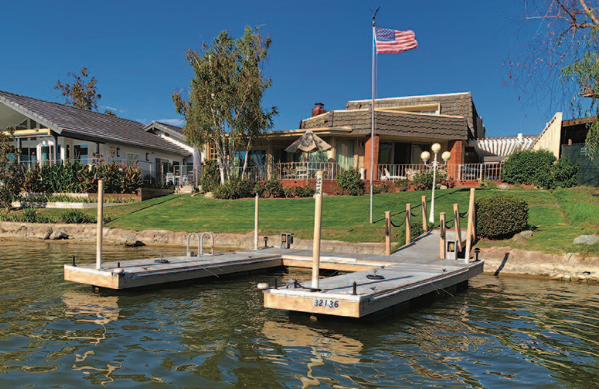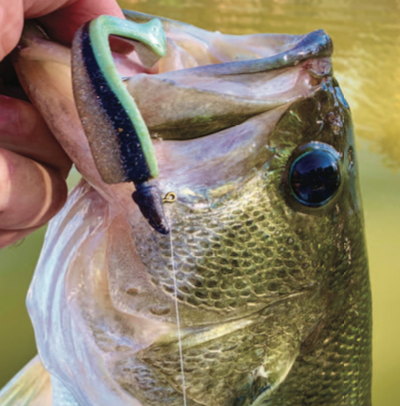
Late-fall and early-winter bass fishing in our Southern California lakes doesn’t always go like it’s supposed to. You may start out with high hopes and a well-thought out gameplan for locating bass that’s proven successful in the past, only to find no one home in the spots that had traditionally paid off. Now what?
As temperatures drop, bass can be hard to find, and even when you do find them, they can be downright finicky. Aren’t they supposed to be putting on their feedbags before the winter chill, gobbling up whatever you throw at them? Hmmm. Guess they didn’t get the memo.
Typically, late-fall bass should be moving around in shallower water and following the bait. Often they’ll be around shallow structure like grass beds, weed lines and rocky areas that are close to deep water, or in the backs of coves or creek arms chasing shad and pushing them out of the water in showery displays that jump-start your heart and get you licking your lips. Game on. BUT, what if they’re following a different script? What if they’re MIA? Time to switch gears. Start searching.
BREAK OUT THE SEARCH BAITS
Search baits — like crankbaits, spinnerbaits, chatterbaits and small swimbaits — are good tools for covering water quickly, which is what you need to do when they ain’t where they s’posed to be. Jigs, Senkos, Ned rigs and drop- shots can be effective once you find the fish, but they’ll limit your chances of finding them when they’re on the move because those baits have to be worked slooowly and it will take more time to find the fish, if you’re able to find them at all. Once located you can switch to those baits if you’re so inclined, but use the search baits first.
During the fall transition when the water is still warm, or in post-frontal conditions with no wind and bright skies, one of my favorite type of search baits in shallow water are small 3-inch natural-looking swimbaits that match the hatch — like the Big Hammer or Keitech series — on 1/8-ounce dartheads. Sometimes search baits like a chatterbait or spinnerbait that move a lot of water can be too much commotion for lethargic bass. Or they’ve seen that style of bait too many times and it doesn’t turn them on any longer. In those situations, it may take a finesse approach.
A more subtly presented swimbait may be more to their liking and you can still fan cast a bank using a steady retrieve or speed it up or slow it down until you find what the bass want. Often times when they’re in a funk, you’ll feel them bump the bait but not commit. That’s okay, because at least you’ve found some active fish. Some anglers will then switch to a different colored swimbait in hopes that it will get them to bite, but color doesn’t influence the bass as much as action and retrieve speed. You’re better off going with a swimbait that has a bit more side-to-side motion or refining your retrieve. Maybe you slow it down as it glides over some structure, or speed it up as it bumps off a rock. Do something different if they aren’t eating it on a steady retrieve.
Now that you’re in a zone that seems to be holding fish, use your electronics and don’t forget to use your eyeballs to visually look for spots that look fishy, especially ambush points. Look for spots with moving water around points, rocks, lay-downs and pockets along the shore that they can use to corral the bait. Those spots that seem like there should be a neon sign next to them flashing, “Bass Motel. Cast Here!” There’s usually someone home.
TARGET INFLOWS AND BUBBLERS
Baitfish like oxygenated water. Not all lakes have them, but if you find a spot where water is pouring into the lake, or a bubbler is oxygenating the water, fish it. It’s likely holding baitfish — and bass. I was fishing a small lake last week with a friend and we were picking a bass here and there, but nothing consistent. We made a run to an area that has two large pipes that pour water into the lake at 500 gallons per minute. The pipes are about 40 yards apart and have cattails and reeds lining the bank between them and a rocky shore past the furthest pipe. The water isn’t always turned on, but when it is, it can be a fish magnet.

We got there and were happy to find the water flowing. We caught a few small bass using Senkos, thinking that the bass might be staging in the weeds looking for natural baits like worms that might be stirred up in the mix by the incoming water. I saw a particularly nasty-looking maze of reeds and an overhanging tree that had a tiny opening in it. Target acquired. It would take a perfect cast to skip a bait into it without getting snagged. My launch was on point and I was rewarded with a chunky 3.5-pound bass.
It was now late in the day and as the sun dropped towards the horizon, the fish became more active — the magic hour was upon us. It still took a well-placed cast at snaggy indentations in the weed line, but that last hour before dark turned the fish on and the bigger fish came out to play.
TARGETING BIGGER BASS
Bigger bass don’t get that way by accident. They’re smart. They know when to expend energy and when to conserve it. With winter not far away, they want to feed to bulk up for the cold period, but do so without burning a lot of calories. While the young bucks are up near the surface slashing at schools of baitfish, the bigger fish are often lower in the water column, lying in wait for an easy meal. They’ll just let the wounded and dying baitfish filter down to them and slurp them up.
So, if you’re after bigger bass, resist the temptation of firing away at the smaller bass busting up the bait on top, and use something like a Zoom Fluke rigged on a keel-weighted EWG 4/0 hook or fished with a split shot above an unweighted hook, and twitch it or fish it like a jerkbait to mimic a wounded baitfish. As an alternative, try a heavier but still compact swimbait and let it sink below the surface fray and then start an erratic, stop-and-go retrieve.
TARGETING DOCKS
Another target to look for are docks. And one of the keys to successful dock fishing is determined by how you approach and cast to a dock. Ideally, you want to be as far away as you can be and still be accurate with your casts. Too close and you may spook the fish. You’d be surprised how far the vibration and wake from your trolling motor can be felt by a bass’ lateral line.
If you’re fishing a dock with multiple pontoons or decks to it, there are generally several targets to cast to. You should have mental plan as to where you cast first in case the bass — and there may be more than one holding under it — is under a different section of the dock. You want to make as little commotion as possible so you don’t spook the fish with your cast and place it at one of the outside corners of the dock first. If there’s moving water that sweeps across one of the corners, start there first. If you don’t get bit, make your next cast to the other outside corner, and then work farther back in the shady areas. On bright sunny days, docks create shade pockets in shallow water that bass love and they double as ambush points to attack schools of baitfish. Sometimes the bass are under the footbridge connecting the dock to shore. Pick the dock apart with subtle casts to each target.

If there’s a boat parked next to the dock, bass will oftentimes hold between the boat and the dock. It can take precision casting to hit that target without snagging dock or power lines going from the boat to the dock, but it pays off. I’ve caught a number of jumbo bass in that narrow space. If the boat parked there is a pontoon boat, try a cast with a Senko, Fat Ika or other slow-sinking bait under the boat between the pontoons. Try not to hit the pontoons because that can be like sounding an alarm and warning the bass that a predator is nearby. One of the most exciting moments of casting under boats is when you’re lucky enough to drop the bait on a bass’ head and you get an explosive reaction bite that sends boiling water crashing everywhere. In those situations, the bass tend to inhale the bait and there’s no question that you’re bit. Just set the hook and reel.
Something that has always puzzled me is why bass instinctively swim out of the cover when they realize they’re hooked. I would think the bass caught under boats and docks or in weed lines would swim deeper into the cover instead of out of it. I guess their instincts are to swim to deeper water for safety. Nevertheless, thank you Mr. Bass for making it easier to get you out of your lair.
There are lots of options of how and where to fish for bass when they get finicky in the fall. I hope a few of these ideas get you thinking and put a few more fish in your livewells.



